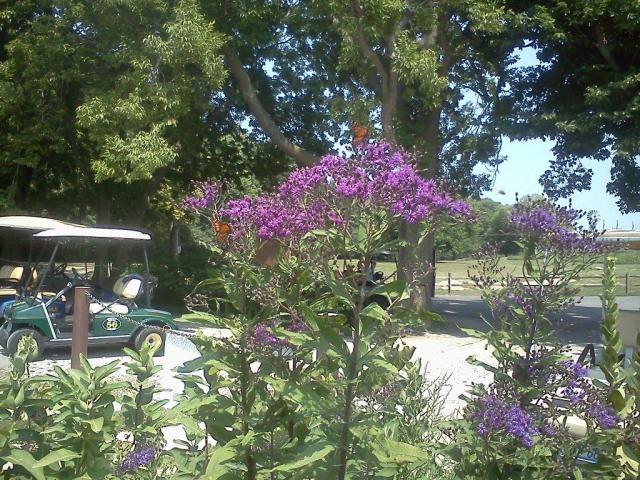
Date: 08/10/2014
Number: 7
This past Sunday, my family and I went to South Bass Island in Lake Erie for the day. I have volunteered at the nature center there for the past 5 years, and regularly visit the island during summers. This Sunday, it was clear the monarch premigration migration was underway.
South Bass island is one of 12 islands located in the middle of Lake Erie. It is south/southwest of Pt. Pelee National Park. From mainland OH
to Pt. Pelee is about 35 miles across the lake. The islands act like "jumping stones" for migrating monarchs crossing Lake Erie. Being the
shallowest of the Great Lakes, it is also the warmest, the water temperature now being 71F.
All season my naturalist friends, and islanders who are long-time monarch enthusiasts, have seen very few monarchs on the islands. In spring, during the northward migration, a naturalist friend who knows where all the milkweed is on South Bass island (not hard, it's a small
island) could not find monarchs on South Bass. Instead, she found a small number of larvae on Gibraltar island. Gibraltar island is a tiny island in the center of South Bass island's shallow Put-in-Bay harbor, and houses Stone Lab, the OSU students base in the Erie islands. There is a small milkweed patch near the boat dock on Gibraltar island, and my naturalist friend, Jackie Taylor, found a few larvae there. But that was it--no monarchs ever sighted all summer at the Lake Erie Islands Nature Center Waystation (on Meechen Rd) on South Bass island, and only one adult sighted at the South Bass Island lighthouse waystation all summer. Publishers of
the island newspaper own a local winery, and their walkway up to the winery is lined with milkweed--they never saw a monarch all summer at the winery either.
Needless to say, when I went to South Bass island on Sunday, I saw 7 monarchs in less than 3 hours of looking. They couldn't be avoided. One was flying around the rock wall at the Kids Adventure center, near the island's Butterfly House. Another flew past our golf cart as we drove by thewinery. I went to the lighthouse Waystation garden (pictured here), and sure enough, I immediately found 3 monarchs nectaring on the ironweed in the center of the garden. I then headed over to the Nature Center, and Jackie happily reported that I had just missed 2 monarchs nectaring in the garden, the first in the garden all season. She said she noticed an influx of monarchs on 8-7-14 (3 days earlier), and was certain this was the premigration. She was just delighted with the activity. We ran into more monarchs near the ferry dock, the boatmen reported seeing them lately.
The lighthouse is adjacent to a 1 acre sunflower patch that is owned by the island's butterfly house owners. Monarchs can arrive to lighthouse point, nectar at the waystation, cross a wind-break of trees, and then nectar in
the sunflower patch just on the other side of the trees. This windbreak of trees is where we always find roosting monarchs in fall, clustered on the leeward side of the trees. The winds at lighthouse point can be very strong, these trees are great shelter.
I will see what happens over the next month. The OSU students will be tagging in September at the lighthouse waystation, I will be doing my annual
program for them as well. They have reported seeing monarchs flying low over the water in the harbor, it is not an unusual seen for them. Sometime, I need to pick the brains of the ferrymen about what they have seen.
South Bass Island, OH
Latitude: 41.6 Longitude: -82.8
Observed by: candy
Contact Observer
The observer's e-mail address will not be disclosed.
Contact will be made through a web-based form.